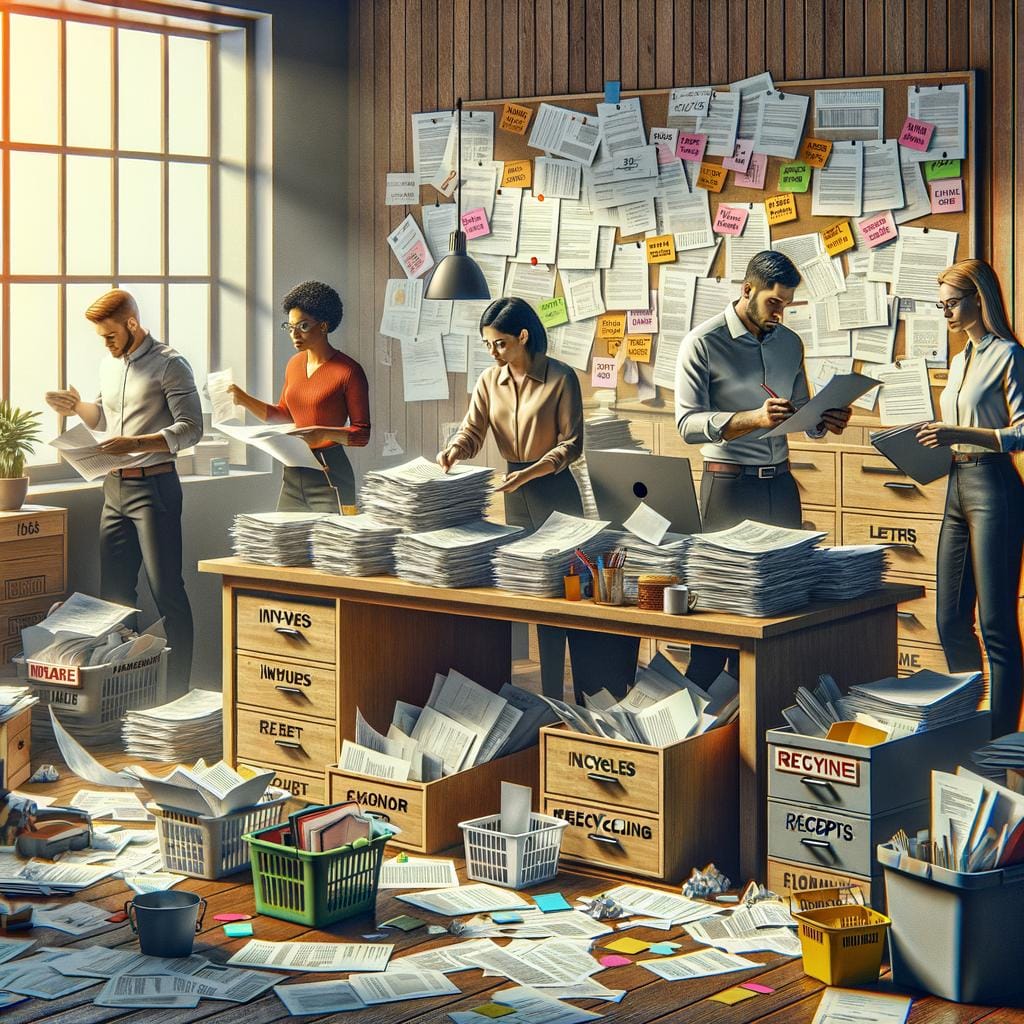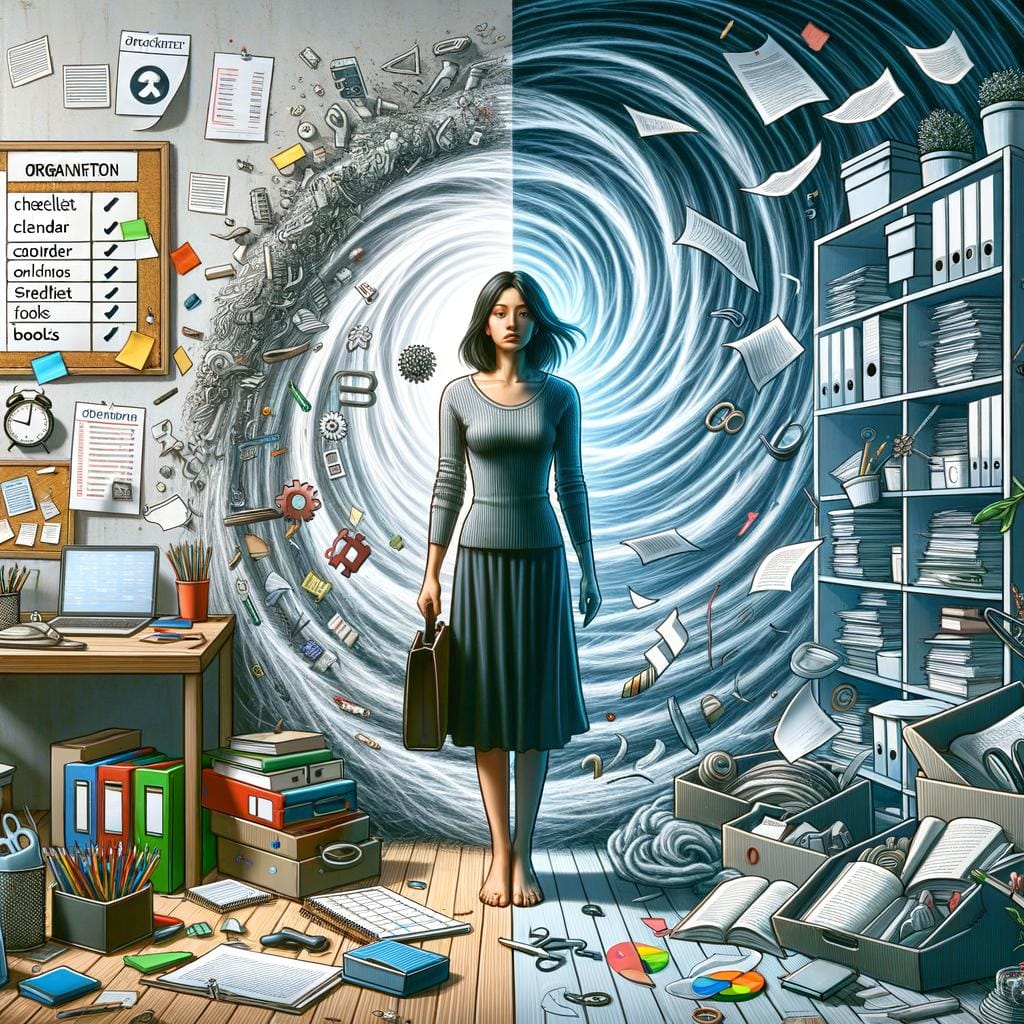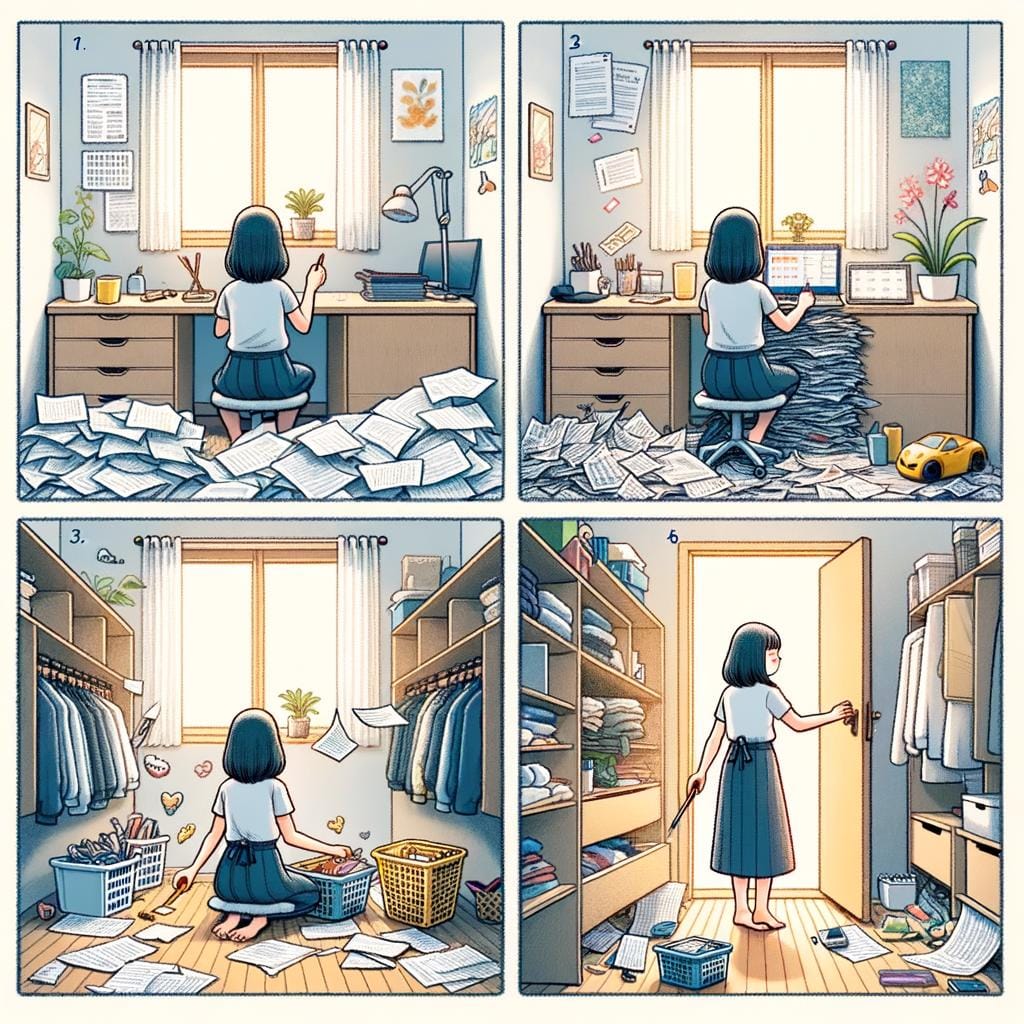Paperwork decluttering routines are essential for maintaining organization and efficiency in both personal and professional settings. In today’s fast-paced world, the accumulation of paperwork can quickly become overwhelming, leading to stress and disorganization. By implementing effective decluttering routines, individuals can streamline their workflow, reduce mental clutter, and increase productivity.
The negative impacts of cluttered paperwork extend beyond just physical mess. Studies have shown that a disorganized workspace can lead to increased levels of stress and anxiety. Untidy documents make it challenging to find important information when needed, resulting in wasted time and potential errors. Understanding these consequences highlights the importance of establishing proper paperwork decluttering routines to promote a clear and focused mind.
To begin sorting through the chaos of paperwork, individuals can utilize various tips and tricks to effectively organize their documents. Whether it’s creating specific categories, implementing a filing system, or utilizing tools like color-coding or labeling, there are numerous strategies to simplify the process. By taking small steps towards decluttering and organizing paperwork, individuals can regain control over their environment and set themselves up for success in the long run.
Why Cluttered Paperwork Can Be Stressful
Having cluttered paperwork can be a significant source of stress and frustration for many individuals. The negative impacts of untidy documents go beyond just a messy desk or overflowing filing cabinets. Cluttered paperwork can lead to feelings of overwhelm, anxiety, and even a sense of being disorganized in one’s life as a whole. It can also result in wasted time searching for important documents, missed deadlines, and ultimately affect one’s productivity.
The Psychological Toll
Psychologically, cluttered paperwork can create a sense of chaos and disarray in your mind. The constant visual reminder of unfinished tasks or looming deadlines can contribute to increased levels of stress and anxiety. Furthermore, the inability to easily locate needed documents can lead to feelings of frustration and helplessness.
Physical Disorganization
From a practical standpoint, having cluttered paperwork can result in physical disorganization in your living or workspace. Piles of unsorted papers can take up valuable space and create additional obstacles to efficient work processes. Moreover, the risk of losing important documents or misplacing crucial information increases when paperwork is not properly sorted and organized.
In essence, by understanding the negative impacts of untidy documents on both your mental well-being and physical environment, you can begin to appreciate the importance of decluttering your paperwork regularly. Implementing effective paperwork decluttering routines will not only help alleviate stress but also improve your overall productivity and efficiency in managing your documents.
Getting Started
Paperwork decluttering routines are crucial for maintaining an organized and stress-free environment, especially in today’s digital age where paper documents can easily pile up. When it comes to getting started on sorting and organizing paperwork, the task may seem daunting at first. However, with the right tips and tricks, you can efficiently tackle this project and create a more streamlined system for managing your documents.
To begin your paperwork decluttering journey, consider the following strategies:
- Start by setting aside dedicated time for this task to avoid feeling overwhelmed. Break down the process into smaller manageable segments if needed.
- Use categories or labels to sort through your paperwork, such as bills, receipts, important documents, and miscellaneous items. This will make it easier to locate specific items when needed.
- Create a filing system that works best for you – whether it’s based on alphabetical order, chronology, or any other method that suits your preferences.
Another helpful tip for organizing paperwork is to regularly purge unnecessary or outdated documents. Set aside time every few months to review your files and discard anything that is no longer needed. This practice will not only free up space but also make it easier to find essential documents when required. By incorporating these tips into your paperwork decluttering routines, you can establish a more efficient and organized system for managing your documents effectively.
The KonMari Method Applied to Paperwork
The KonMari Method, popularized by organization guru Marie Kondo, emphasizes the importance of keeping only items that spark joy in one’s life. While this method is often associated with decluttering physical possessions, it can also be effectively applied to paperwork. By approaching paperwork decluttering with the KonMari mindset, individuals can create a more streamlined and stress-free system for managing their documents.
Sorting Through Paperwork With Intention
When applying the KonMari Method to paperwork decluttering, it’s essential to start by gathering all documents in one place. Take each piece of paper in your hands and ask yourself if it truly serves a purpose or brings you joy. This process can help you determine which documents are necessary to keep and which ones can be discarded. Remember, the goal is not just to organize your paperwork but also to create a space that resonates positivity and clarity.
Organizing Paperwork in Categories
Once you have sorted through your paperwork, categorize them into specific groups such as financial documents, personal records, or household bills. Utilize folders or file organizers to neatly store each category separately.
By assigning a designated spot for each type of document, you not only make it easier to locate what you need but also maintain a sense of order within your filing system. The KonMari Method focuses on simplicity and efficiency, so aim to create a system that is easy to maintain long-term.
Setting Up a Dedicated Workspace for Managing Paperwork
Setting up a designated workspace for managing paperwork is essential in establishing an effective system for decluttering and organizing your documents. Having a specific area dedicated to handling paperwork will not only help you stay focused but also streamline the process of sorting through papers. Here are some tips on how to create an efficient workspace for managing your paperwork:
- Choose a well-lit area with good ventilation to set up your workspace. Natural light can help reduce eye strain and improve your overall work environment.
- Invest in organizational tools such as file folders, binders, label makers, and trays to keep your documents sorted and easily accessible.
- Make sure you have a comfortable chair and desk setup that promotes good posture to prevent any physical discomfort while working on paperwork.
Creating a clutter-free environment in your workspace is important for maintaining focus and productivity. Clearing out unnecessary items from your desk and surrounding areas can create a calming atmosphere that enhances your ability to tackle paperwork effectively. Here are some additional tips to consider when setting up your dedicated paperwork management area:
- Keep only essential items within reach, such as pens, paper clips, and sticky notes, to minimize distractions while sorting through documents.
- Create zones in your workspace for different types of paperwork (e.g. bills, receipts, important documents) to ensure everything has its place.
- Regularly declutter and organize your workspace by removing any outdated or irrelevant papers to prevent the buildup of unnecessary clutter.
By following these tips and setting up a dedicated workspace for managing paperwork, you can establish a more efficient system for decluttering and organizing your documents. The key is to create a space that is conducive to productivity and allows you to focus on the task at hand without being overwhelmed by clutter. This will ultimately lead to improved mental clarity, increased productivity, and reduced stress related to managing paperwork.
Digital vs Physical
Transitioning from a physical paperwork system to a paperless one can seem like a daunting task, but the benefits are numerous. By going digital, you can save space, reduce clutter, and easily access your documents from anywhere with an internet connection. However, making the switch requires careful planning and organization.
One of the first steps in transitioning to a paperless system is digitizing your existing paperwork. Invest in a good scanner or use scanning apps on your phone to create digital copies of important documents. Be sure to organize these digital files into folders on your computer or cloud storage for easy retrieval.
Once you have digitized your paperwork, it’s essential to establish a system for ongoing document management. Create folders and subfolders on your computer that mirror your physical filing system. Regularly scan new documents as they come in and file them appropriately in the digital folders. Consider using software or apps specifically designed for document management to streamline the process and avoid clutter.
Remember that going paperless doesn’t mean getting rid of all physical documents entirely. Some important papers may still need to be kept in their original form, such as birth certificates, passports, or legal documents. Create a separate filing system for these items and ensure they are securely stored. By maintaining a balance between digital and physical document storage, you can effectively declutter your paperwork while still keeping essential hard copies on hand.
Weekly Paperwork Maintenance Routine
Paperwork decluttering routines are essential for maintaining an organized and stress-free environment. Once you have sorted and organized your documents using the tips and tricks mentioned earlier, it is crucial to establish a weekly paperwork maintenance routine to ensure that your hard work does not go to waste. By dedicating a small amount of time each week to managing your paperwork, you can prevent clutter from building up again and maintain order in your space.
One effective strategy for keeping your documents organized on a weekly basis is to set aside a specific day or time for paperwork-related tasks. This could be at the beginning or end of the week, depending on your schedule and preferences.
Use this time to review any new documents that have accumulated, file them accordingly, and discard any unnecessary papers. By consistently setting aside this time, you can prevent overwhelming amounts of paperwork from piling up and stay on top of important deadlines and information.
Another useful tip for maintaining organized paperwork is to create a system of categories or folders for different types of documents. Whether it’s bills, receipts, tax forms, or personal letters, having designated spaces for each type of paper will make it easier to locate what you need when you need it.
Consider labeling these categories clearly and consistently so that anyone else who may need to access the documents can do so efficiently. Regularly reviewing and updating these folders during your weekly maintenance routine will help you stay organized in the long run.
| Tip for Maintaining Organized Paperwork | Benefits |
|---|---|
| Create specific categories or folders for different types of documents | Easier access to needed materials, efficient organization |
| Set aside dedicated time each week for paperwork management | Prevent overwhelming clutter buildup, stay on top of deadlines |
Utilizing Technology to Streamline Your Paperwork Decluttering Process
In today’s digital age, technology can play a significant role in streamlining and optimizing paperwork decluttering routines. There are various software applications and tools available that can help individuals effectively manage and organize their documents with ease. One popular method is to utilize document management systems that allow for easy scanning, storage, and retrieval of important papers.
By digitizing your paperwork, you can reduce the physical clutter in your space while still having access to important documents whenever you need them. With the use of cloud storage services like Google Drive, Dropbox, or Evernote, you can securely store all your files online and access them from any device. This eliminates the need for bulky filing cabinets and allows for a more efficient organization system.
Furthermore, there are apps specifically designed to aid in decluttering paperwork. These apps often come with features such as optical character recognition (OCR) technology, which can extract text from scanned documents for easy searching. Some apps even have built-in reminders and notifications to help you stay on top of your paperwork decluttering routines. Overall, technology offers a convenient and modern approach to managing your documents effectively.
| Benefits of Utilizing Technology for Paperwork Decluttering | Examples |
|---|---|
| Reduced physical clutter | Google Drive, Dropbox |
| Improved accessibility | Evernote |
| Innovative features such as OCR technology | Various document management apps |
Final Thoughts
Establishing paperwork decluttering routines is not just about tidying up your physical space; it can also have a profound impact on your mental clarity and productivity. By creating a system for organizing and managing your documents, you are able to alleviate the stress and anxiety that often comes with cluttered paperwork. Having a clear and organized workspace can help you focus better, think more clearly, and ultimately be more productive in your daily tasks.
Moreover, maintaining a clutter-free environment can help reduce feelings of overwhelm and allow you to approach your work with a sense of calm and control. When you know exactly where to find important papers or files, you can avoid wasting time searching for misplaced documents or dealing with the frustration of missing deadlines due to disorganization. A well-maintained paperwork system can also boost your confidence and efficiency in handling tasks efficiently.
In conclusion, incorporating paperwork decluttering routines into your regular schedule is not just a matter of keeping things neat and tidy; it is a fundamental aspect of improving your overall well-being. By implementing the tips and strategies mentioned in this article, such as utilizing technology, setting up dedicated workspaces, and establishing weekly maintenance routines, you can create a streamlined and efficient system for managing your documents.
Ultimately, embracing the practice of decluttering paperwork will not only improve your physical space but also enhance your mental clarity, reduce stress levels, and increase productivity in all aspects of your life.
Frequently Asked Questions
What Is the Fastest Way to Declutter Paperwork?
The fastest way to declutter paperwork is to start by sorting them into different categories such as bills, receipts, and important documents. Then, go through each category and decide what to keep, what to shred, and what to throw away.
How Do I Get Rid of Years of Paper Clutter?
Getting rid of years of paper clutter can be a daunting task, but it’s possible with a systematic approach. Start by gathering all the paper piles in one place. Then, go through each document one by one and make decisions about whether to keep, shred, or toss it. Consider using digital storage for important documents to reduce future clutter.
What Is the 20 20 20 Rule for Decluttering?
The 20 20 20 rule for decluttering suggests spending 20 minutes per day organizing items, 20 minutes cleaning up messes or decluttering spaces, and the last 20 minutes on self-care or relaxation activities. This rule helps break down decluttering tasks into manageable chunks while also prioritizing self-care in the process.

Hello, I’m April Denton, your go-to expert for all things home decluttering and organization. With over a decade of experience helping individuals transform their living spaces into serene, clutter-free sanctuaries, I am passionate about the life-changing benefits of decluttering. My journey into the world of organization began out of necessity, juggling a busy career and a bustling household. I quickly realized that a well-organized home was the key to a more balanced, stress-free life.





